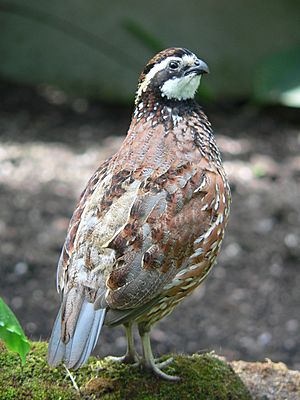Game bird facts for kids
Game birds are wild birds that people hunt for sport and for food. This practice happens in many countries around the world. However, the specific rules and ways of hunting can be different from place to place.
Usually, there are special laws that control hunting. These laws often cover things like using guns. They also protect the birds during their breeding season. This helps make sure that new generations of birds can grow and replace the ones that are hunted.
Even though game birds are wild, many of them are "managed" if they live on large estates. This means people look after the land to make sure there are enough birds for future hunting seasons. Birds that migrate (travel long distances) are harder to manage in this way. For places like Scottish estates, hunting game birds is a big way they earn money.
Rules for Hunting Game Birds
In the UK, game birds are defined by a law called the Game Act 1831. This law makes it illegal to hunt game birds on Sundays or at night. Other wild birds that are hunted for food in the UK are listed under a different law, the Wildlife and Countryside Act 1981.
Important groups like the Royal Society for the Protection of Birds (RSPB) and the Forestry Commission help decide how hunting is regulated. They work to make sure hunting is done in a way that protects bird populations.
Types of Game Birds in the UK
UK law lists several types of birds as game. Some of these are:
- Black grouse (These are no longer hunted because their numbers have dropped)
- Red grouse
- Brown hare
- Ptarmigan
- Grey partridge and red-legged partridge
- Common pheasant
Other birds that are hunted for food in the UK include:
- Ducks, such as mallard, tufted duck, teal, pintail, and pochard
- Gooses, including greylag goose, Canada goose, pink-footed goose, and in England and Wales, the white-fronted goose
- Wood pigeon
- Woodcock
- Snipe
- Golden plover
Images for kids
-
Despite its distinct appearance, the wild turkey is actually a very close relative of pheasants
-
Palaeortyx skeleton, Muséum national d'histoire naturelle, Paris
-
Female (left) and male common pheasants: Sexual dimorphism is conspicuous in this species, one of the most apomorphic gamefowl
-
Flock of adult and young helmeted guineafowl foraging
-
During mating season, the male western capercaillie feeds mainly on bilberry leaves, which are toxic to most herbivores
See also
 In Spanish: Carne de caza para niños
In Spanish: Carne de caza para niños








